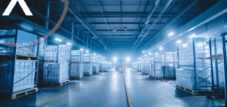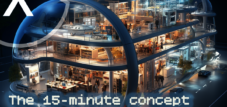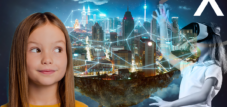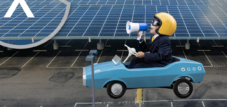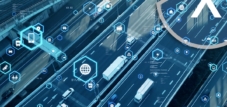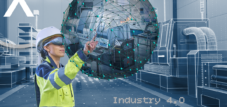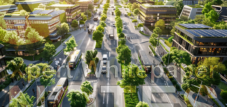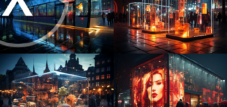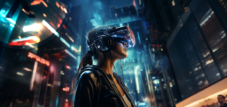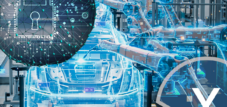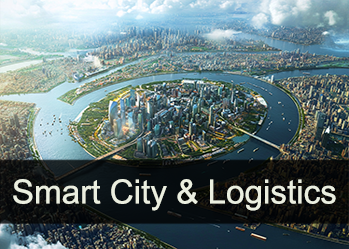Smart City, Factory, Logistics and Industrial Metaverse: It's actually already here, the puzzle pieces just need to be brought together
Language selection 📢
Published on: June 29, 2024 / update from: June 29, 2024 - Author: Konrad Wolfenstein
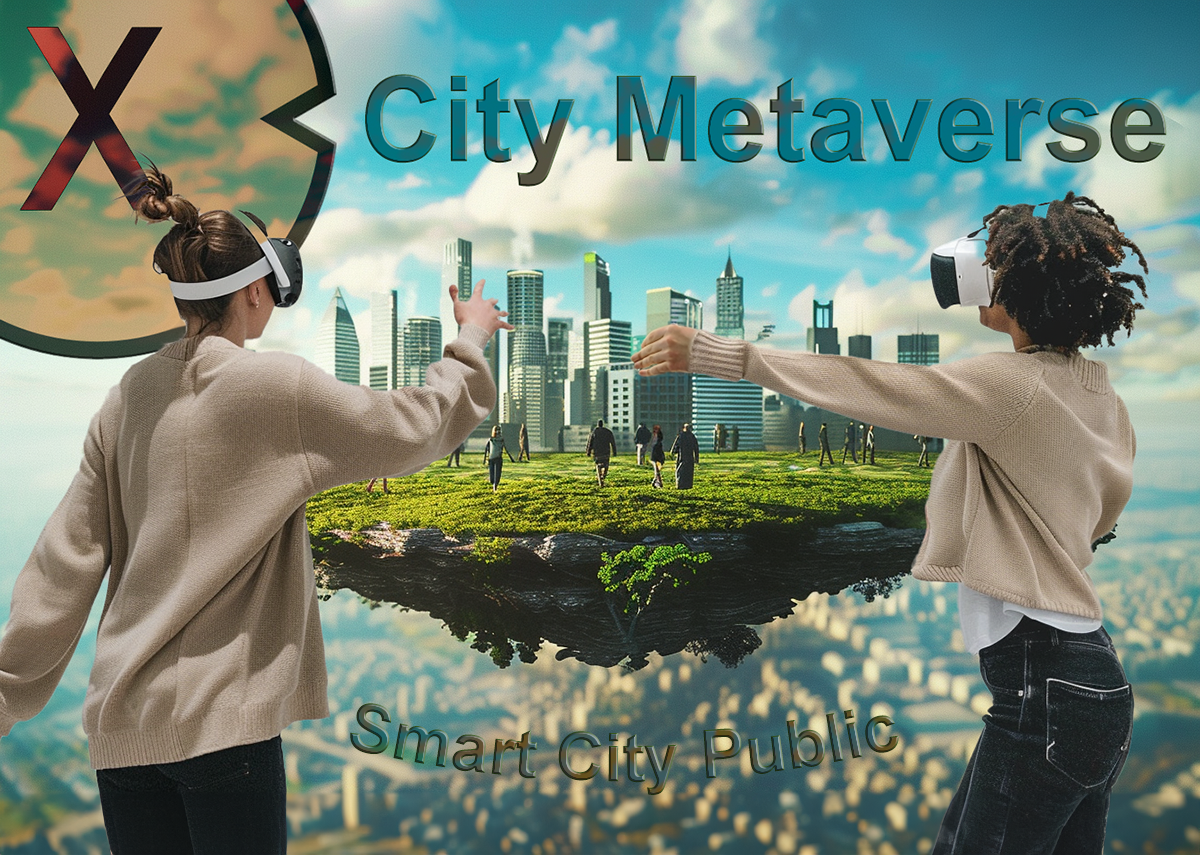
Smart City, Factory, Logistics and Industrial Metaverse: It's actually already here! – Image: Xpert.Digital
🌳🏢🔍 Future-proof urbanization and modern industry 🌞🤖📶
🌀 The vision-independent metaverse
🌟 First, a common misunderstanding must be clarified: The Metaverse is vision independent. This means that access and interaction are not tied to a specific visual device, especially not just virtual reality (VR) glasses. This widespread fallacy would be a visionary step backwards. In fact, the Metaverse is a smart 3D world that you can enter or immerse yourself in with any visual device, be it a computer screen, a tablet, a smartphone, a touch screen, screen power wall or even a mixed reality ( MR) or VR glasses.
📖 The word “verses” is derived from the Latin “versus”, which means “turn” or “direction”. This reflects the flexibility and diversity of the access options for metaverse. It is up to the users to freely decide which aids they want to enter the meta level in the meta verse. This "meta-free meta-decision" enables wider accessibility and use of the meta pubic and promotes the integration of various technologies and applications.
🧩 The Metaverse: The Future of Integration
🔧 The Metaverse is basically already there and consists of many different puzzle pieces that now need to be brought together to have their full effect. These puzzle pieces include various concepts and technologies, such as the City, Factory, Logistics and Industrial Metaverse.
🏭 Industry and technology
⚙️ Let's first look at the area of industry, especially Industry 4.0, as well as mechanical engineering, the smart factory and smart logistics. This is about the integration of sensors and ERP platforms. Sensor technology includes technologies such as RFID, cameras, LIDAR and 3D sensors that are used in the areas of logistics, intralogistics and production. This data and technology is integrated into ERP platforms, which serve as software systems to control the entire company. ERP supports automation and processes in areas such as finance, human resources, manufacturing, supply chain, services and procurement. However, until now these systems have been based primarily on two-dimensional representations.
🌐 With the advent of the Metaverse and XR technologies (Extended Reality, which includes both virtual reality and augmented reality), visualization is advancing into the third dimension, creating numerous new possibilities that were previously not possible in 2D representation . This 3D visualization enables an immersive and more comprehensive perspective on complex data and processes.
📶 5G technology and especially the 5G campus networks, which enable real-time display of data, play a crucial role. This makes digital twins possible, which can be used for control, testing and many other applications. A digital twin is an exact virtual copy of a physical system that enables location-independent work and collaboration between different competencies from different locations. This becomes particularly relevant when travel to work can be eliminated, the regional shortage of skilled workers is compensated for by global skilled workers and other advantages can be exploited.
⌛ A particularly important aspect is that all data and information is updated almost in real time, thereby enabling fast, automated and, if necessary, flexible processes and decisions. An example of this would be a production line in a factory that is monitored and controlled in real time using sensors and 5G. In the event of an unexpected machine downtime, appropriate measures could be taken immediately to minimize downtime, resulting in cost savings and increased efficiency.
📡 Connectivity and innovation
🏭 The term “Industrial Metaverse” describes a vision in which these technologies and connectivity come together to significantly improve industrial processes and operations. This merger not only enables the optimization of current working methods, but also opens up paths to completely new business models and services.
🤖 Another important component are smart factories, which differ from the traditional production concept by using the latest technologies. Smart factories use sensors, IoT (Internet of Things), AI (artificial intelligence) and machine learning to monitor, control and optimize production processes. By integrating into the Metaverse, these factories will become even smarter and more efficient. For example, digital twins can be used to plan machine maintenance more precisely by simulating predictable maintenance scenarios and performing real-time condition monitoring.
🚚 Logistics in the digital age
🚚 The Metaverse also offers great advantages in logistics. The logistics industry is constantly faced with challenges such as optimizing supply chains, reducing delivery times and cost efficiency. By using 5G, IoT and digital twins, logistics processes can be monitored and adjusted in real time, resulting in greater flexibility and efficiency. Truck fleets can be further supplemented through the use of autonomous vehicles and drones, which can be precisely monitored and controlled through 3D visualization within the Metaverse.
🏙️ Smart Cities: The future of urban living spaces
🏘️ In addition, the metaverse enables the development of smart cities in which various urban systems - from traffic control to energy supply to public safety - are networked together. This leads to more sustainable and livable cities. For example, traffic systems can be controlled using real-time data and sensors in such a way that traffic congestion is minimized and public transport is made more efficient. Smart buildings also offer personalized services and high levels of energy efficiency through connected systems and devices.
Suitable for:
🛠️ Work and Collaborate in the Metaverse
🕶️ In practice it could look like this: A worker in a smart factory enters the factory and is supported by AR glasses that provide him with real-time data about the machines and production processes. He can immediately see which area needs special attention and which machines need maintenance. At the same time, this information is synchronized with the ERP system so that the management level always has an up-to-date overview of the entire production.
🌍 The ability to bring global specialists together virtually whenever necessary also increases the rate of innovation. For example, specialists can work together in “virtual space” to solve complex problems or develop new products without having to be physically present. This not only promotes collaboration, but also saves time and costs.
🎓 Training and development in the digital space
🎓 Another advantage of Metaverse in the industry is the ability to conduct education and training in a safe, controlled environment. New employees can be trained in virtual simulations, which reduces the risk of errors in real operations and shortens training time. Even complex operations can be simulated and optimized in advance, improving decision-making and planning.
🚀 The Metaverse and its associated technologies have the potential to fundamentally transform the industrial world. The integration of real-time data, 3D visualizations and global networking creates new opportunities to optimize processes, increasing efficiency and reducing costs. At the same time, the Metaverse opens up new horizons for innovation and collaboration that were previously unthinkable. The necessary technologies are already available; All that is required is the consistent and intelligent connection of these puzzle pieces to realize the full potential and reshape the future of the industry.
📣 Similar topics
- 🚀 The Metaverse Future of the Industry
- 🏗️ Industry 4.0: The role of the Metaverse
- 🕹️ VR and AR in the Smart Factory
- 🌐 Digital twins for industry
- 🌱 Sustainable Smart Cities in the Metaverse
- 📡 5G campus networks and real-time data
- 🤖 Automation and AI in the Metaverse
- 📦 Future of logistics in the metaverse
- 🛠️ Virtual training and education
- 👾 Innovative collaboration in virtual space
#️⃣ Hashtags: #Metaverse #Industrie40 #SmartFactory #DigitaleZwillinge #5G
🎯🎯🎯 Benefit from Xpert.Digital's extensive, fivefold expertise in a comprehensive service package | R&D, XR, PR & SEM
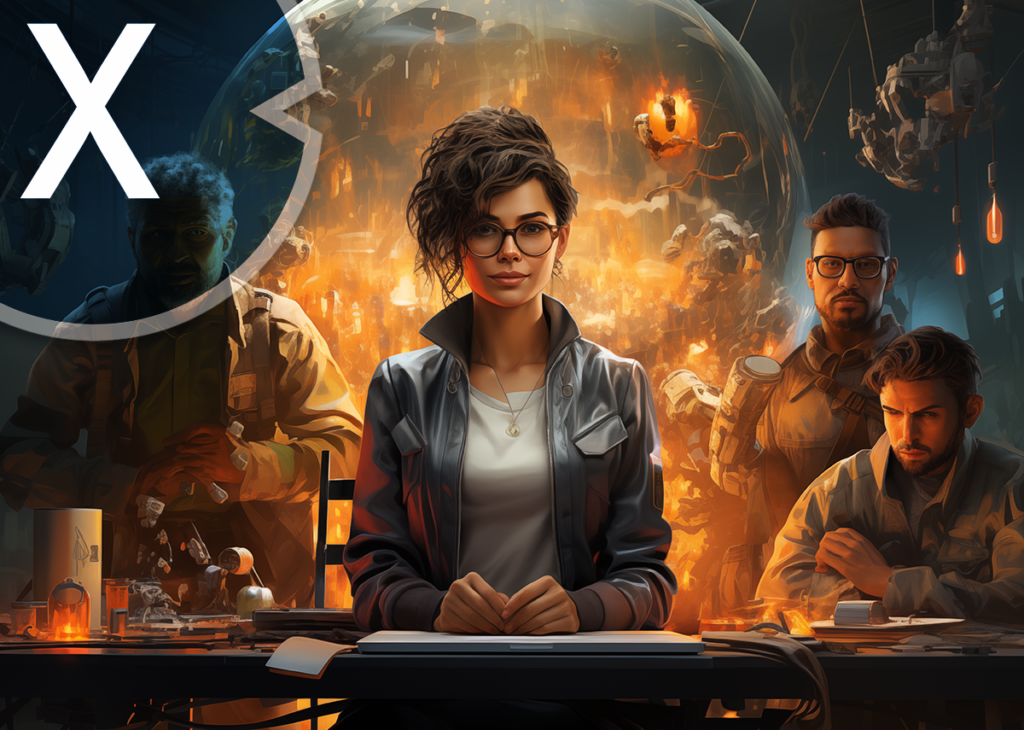
AI & XR 3D Rendering Machine: Fivefold expertise from Xpert.Digital in a comprehensive service package, R&D XR, PR & SEM - Image: Xpert.Digital
Xpert.Digital has in-depth knowledge of various industries. This allows us to develop tailor-made strategies that are tailored precisely to the requirements and challenges of your specific market segment. By continually analyzing market trends and following industry developments, we can act with foresight and offer innovative solutions. Through the combination of experience and knowledge, we generate added value and give our customers a decisive competitive advantage.
More about it here:
🏙️ From the Smart City to the Smart City Public: The City Metaverse
🌐 The term “smart city” refers to the use of concepts and technologies that serve to make urban life more efficient, sustainable and worth living. This is achieved through the seamless integration of information and communication technologies (ICT) into the urban infrastructure. This includes systems for optimizing traffic flow, intelligent street lighting, efficient waste management, modern water supply and advanced security services. But the future of urban development goes even further: it aims at the Smart City Public and the City Metaverse.
🌆 Smart City Public: Citizen involvement and transparency
One of the essential extensions of the traditional Smart City is the integration of the public sector through the Smart City Public. This expansion stage places particular emphasis on citizen participation and engagement as well as on the transparency of city data.
🗣️ Public participation
In Smart City Public, the focus is on citizen participation and public consultation. Innovative platforms are being developed that enable citizens to actively participate in the planning and implementation of smart city initiatives. These also include participation processes in which citizens can express their opinions on city projects and services. This not only creates more transparency, but also promotes citizens' trust in their local administrative structures and strengthens a sense of community.
📊 Data and transparency
The collection and use of data is another central aspect of Smart City Public. Urban data is collected, analyzed and used to improve services and infrastructure. In contrast to the traditional approach, Smart City Public ensures a high level of transparency. The data is accessible to the general public, which increases the transparency of city actions and promotes citizen engagement. A transparent data policy helps to build trust and strengthen citizen participation.
🌐 The City Metaverse: Virtual Integration and Logistics in the Smart City Public
The concept of the City Metaverse represents another innovative dimension in the development of smart cities. It is an augmented reality that connects physical and virtual worlds to better address logistical and infrastructural challenges. Smart City Public also includes public participation, which, with the expansion of 3D visualization, represents the city metaverse.
🕹️ 3D visualization and virtual services
The City Metaverse enables 3D visualization of urban spaces and provides a platform for virtual urban services. For example, if the 15-minute city – where all major services should be accessible within 15 minutes on foot or by bike – cannot be fully implemented due to structural or logistical constraints, the City Metaverse offers a solution. Virtual services can be designed to be accessible across the metaverse, reducing traffic and alleviating parking problems in city centers.
Through the City Metaverse, citizens can access city government services without having to be physically there. This includes administrative processes, citizen consultations, digital citizen services and even virtual city tours. Integrating these services into a virtual environment allows for greater efficiency and accessibility.
🚗 Advantages of the City Metaverse
1. Reduced traffic
Virtual services can reduce the need for physical mobility, which has a positive impact on traffic flow and reduces congestion.
2. Environmental friendliness
Fewer trips mean a reduction in emissions and promote sustainability.
3. Increased accessibility
Citizens with reduced mobility or those who live far from administrative centers can use city services more easily.
4. Increased efficiency
Virtual platforms enable faster and more efficient administrative processes.
🏢 Other aspects of Smart City Public
In addition to public participation, transparency and the integration of virtual worlds, Smart City Public also includes other important aspects:
Integration of renewable energies
A central pillar of Smart City Public is the increased use of renewable energies. Intelligent power grids (smart grids) are used to distribute energy efficiently and manage peak loads. Solar systems, wind power plants and energy storage solutions are seamlessly integrated into the urban infrastructure to ensure a sustainable energy supply.
Smart buildings and infrastructure
Buildings and urban infrastructure are also becoming increasingly intelligent. They are equipped with sensors and automated systems that optimize energy consumption, safety and comfort. Smart buildings can react autonomously to environmental conditions, reduce energy consumption and improve the quality of life of their residents.
Advanced mobility solutions
Mobility within the Smart City Public is improved through a variety of innovative solutions. These include autonomous vehicles, improved public transport systems and extensive networks of bicycle and pedestrian routes. These measures contribute to creating a more sustainable and efficient urban mobility landscape.
Healthcare and Education
The healthcare system and educational institutions also benefit from the progress of Smart City Public. Telemedicine and digital learning platforms help make healthcare and education more accessible and efficient. Smart healthcare solutions enable telemedicine consultations and remote patient monitoring. Digital tools are used in educational institutions to promote interactive learning and make educational resources more accessible .
🌍 Challenges and future perspectives
Despite the numerous advantages, the implementation of Smart City Public also poses challenges. One of the biggest challenges is balancing technological advances with protecting citizens' privacy and security. The huge amounts of data collected require robust security measures to prevent misuse and data breaches.
Another aspect is financing and access to technologies. While progressive cities may have the resources to implement such systems, smaller or less affluent cities may have difficulty making these investments.
🚀 Smart City to Smart City Public and on to the City Metaverse
The development from the Smart City to the Smart City Public and further to the City Metaverse marks a significant advance in urban living. By incorporating public participation, increased transparency and virtual platforms, cities are striving to become more livable, efficient and sustainable. Despite the existing challenges, these developments offer far-reaching opportunities to fundamentally transform urban life and redefine the future of urban spaces.
In this increasingly digital world, the integration of virtual and physical realities through the City Metaverse represents a further step towards connected, efficient and responsible urban design. It will be exciting to see how these visions of the future are further advanced and take concrete shape through technological innovation and citizen engagement.
📣 Similar topics
- 📣 Smart City Expansion: The Role of the City Metaverse
- 💡 Efficient transport and sustainable mobility in the Smart City Public
- 🏙️ Citizen involvement and transparency in the Smart City Public
- 🌐 City Metaverse: Virtual worlds and urban integration
- 📊 Data and Transparency: The Foundation of Smart City Public
- 🚲 Intelligent mobility solutions for sustainable cities
- 🏥 Healthcare and Education in the Smart City Public
- 🔋 Integration of renewable energies in the Smart City Public
- 🏠 Smart buildings and infrastructure for a liveable city
- 🔐 Challenges and perspectives of Smart City Public
#️⃣ Hashtags: #SmartCity#CityMetaverse #Citizen Participation #Sustainability #Technology
📌 Other suitable topics
🌆🚀✨ The Future of the City: Smart City and the City Metaverse 🌌📊👓
🌐 Transition to the new urban era
In recent years, the Smart City has emerged as an increasingly important concept for urban development and administration. In this networked city of the future, different data and information will be brought together to increase the quality of life of residents and at the same time use resources more efficiently. Currently, the smart city concept covers areas such as street light management, local public transport, traffic control, energy supply, environmental management and water management.
🚀3D visualization in the Metaverse: A new impulse
An important impetus for the further development of the Smart City is the step from the previous 2D representation of the existing data to 3D visualization in the metaverse. This transformation opens up a multitude of new possibilities. In particular, the integration of real-time, current data and the presentation of all relevant information at a glance enable faster and more flexible decisions. Processes that are constantly repeated can be made more efficient through automation. This not only means that work is simplified, but also that transparency is guaranteed at all times, regardless of location.
🏙️ Virtual rooms for better communication 🗣️
A particularly outstanding aspect of 3D visualization in the Metaverse is the creation of a virtual space that enables better location-independent communication. This is particularly important for citizen participation and joint planning and decisions. The hurdles that are otherwise associated with organizing events, such as finding suitable rooms or providing parking spaces, are eliminated in virtual space. Virtual rooms and group meetings can be organized at the touch of a button. This not only speeds up decision-making processes, but also promotes close cooperation between authorities and citizens.
⏱️🚲 The 15 Minute City Model and the Metaverse
The addition of the City Metaverse to the 15-minute city model enables more relaxed and efficient city planning and development. The 15-minute city model aims to ensure that all essential facilities and services, such as schools, supermarkets, medical care and leisure options, are within 15 minutes on foot or by bike. By integrating the Metaverse, this concept can be further optimized. Virtual services and facilities can complement physical infrastructure, resulting in a better balance between urban and virtual spaces.
💡 Street light management in the smart city
An example of this is street light management. In a smart city, sensors are used to adjust the brightness and energy consumption of street lights in real time. This data can be visualized in a 3D model, helping city planners immediately identify problem areas and make adjustments without having to be physically there. Such data can also be used to improve energy efficiency and reduce CO2 emissions.
🚍 Public transport and real-time data
In the area of public transport, the Metaverse enables direct and clear visualization of current traffic data. For example, passengers could see in real time which buses or trains are late and alternative routes are displayed. This not only encourages the use of public transport, but also reduces the stress and inconvenience associated with delays and missed connections.
🚦🚗 Intelligent traffic control using VR
Traffic control is another example where integrating real-time data and 3D visualization brings benefits. By displaying traffic information in a 3D model of the city, bottlenecks and traffic jams can be identified and avoided at an early stage. Traffic control centers could use virtual reality glasses to monitor the entire traffic flow in a city in three dimensions and in real time. This would significantly increase the efficiency of traffic control and contribute to a better distribution of traffic volume.
⚡🔋 Optimized energy supply through smart grids
The energy supply can also be optimized through the metaverse. In a smart grid, data is collected from sensors in households, industrial plants and power networks. By visualizing this data in a 3D model, energy flows and consumption can be monitored and controlled more efficiently. This enables better integration of renewable energies and a reduction in energy costs.
🌿🌍 Environmental management in virtual space
Environmental management also benefits from 3D visualization and the metaverse. Sensor data on air quality, noise pollution and other environmental factors can be displayed in a detailed, virtual model of the city. This allows urban planners and environmental scientists to respond promptly to problems and take action to improve citizens' quality of life. For example, green spaces and parks could be strategically planned to provide maximum air quality benefits.
🚰💧 Integrative water management in the metaverse
Water supply and management are other critical areas that can be revolutionized by the Metaverse. By integrating sensors into water supply systems, leaks and other problems can be immediately detected and visualized. This information can be represented in a 3D model of the infrastructure, allowing maintenance teams to respond quickly without having to spend time searching for the source of the problem. This leads to more efficient use of water resources and a reduction in operating costs.
🏘️🗳️ Virtual citizen participation and transparency
Another exciting application scenario of the Metaverse in the Smart City is virtual citizen participation. With 3D visualization, citizens can participate in planning processes and express their opinions on new projects in a virtual space. This could be done, for example, through virtual town hall meetings or interactive city models, where citizens can enter their suggestions directly into the model and see the possible impacts in real time. Such a system promotes transparency and opens the planning process to broader participation.
🌐🏙️ Integration and cultural change in urban planning
The integration of 3D visualization and the Metaverse ushers in not only technological advances, but also a cultural shift in the way cities are planned and managed. By creating a virtual, transparent and participatory space, urban development can be made more efficient, sustainable and closer to citizens. The City Metaverse offers us a vision of the city of the future, where technology and people work together in harmony for a more livable environment.
📣 Similar topics
- 🌆 Connected Cities: The Role of 3D Visualization in the Metaverse
- 🚀 Revolutionary urban development: From 2D to 3D in the Metaverse
- 🏙️ Citizen participation 2.0: Virtual spaces for more transparency
- ⏱️ The 15 Minute City Model meets the Metaverse
- 💡 Efficient street light management through 3D data
- 🚍 Future of mass transit: real-time data in the metaverse
- 🚦 Traffic control rethought: Virtual reality in use
- ⚡ Intelligent energy supply in the City Metaverse
- 🌿 Environmental management in the Metaverse: Sustainable urban planning
- 🚰 Modern water management: 3D models in use
#️⃣ Hashtags: #SmartCity #Metaverse #Citizen Participation #City Planning #Digitalization
We are there for you - advice - planning - implementation - project management
☑️ Industry expert, here with his own Xpert.Digital industry hub with over 2,500 specialist articles
I would be happy to serve as your personal advisor.
You can contact me by filling out the contact form below or simply call me on +49 89 89 674 804 (Munich) .
I'm looking forward to our joint project.
Xpert.Digital - Konrad Wolfenstein
Xpert.Digital is a hub for industry with a focus on digitalization, mechanical engineering, logistics/intralogistics and photovoltaics.
With our 360° business development solution, we support well-known companies from new business to after sales.
Market intelligence, smarketing, marketing automation, content development, PR, mail campaigns, personalized social media and lead nurturing are part of our digital tools.
You can find out more at: www.xpert.digital - www.xpert.solar - www.xpert.plus




